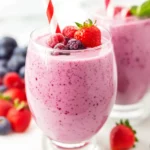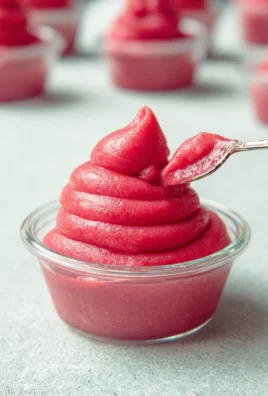A berry smoothie with oatmeal is a delicious and nutritious way to start the day. Packed with fiber, protein, and antioxidants, this smoothie is not only tasty but also incredibly filling. Whether you’re looking for a post-workout meal, a quick breakfast, or a healthy snack, this smoothie delivers on all fronts.

Smoothies have long been a staple in health-conscious diets, and for good reason. They are easy to make, customizable, and loaded with vitamins and minerals. Adding oatmeal to a smoothie takes it to the next level, providing a satisfying texture while offering slow-digesting carbohydrates to keep you energized for hours.
This guide will cover everything you need to know about making the perfect berry smoothie with oatmeal. From choosing the right ingredients to mastering blending techniques, you’ll have all the knowledge needed to create a smoothie that’s both delicious and nutritious.
Overview of Berry Smoothie with Oatmeal
A berry smoothie with oatmeal combines the sweetness of berries, the creaminess of yogurt, and the heartiness of oats to create a well-balanced and nutrient-packed drink. Here’s why this smoothie stands out:
- Rich in Fiber: Oatmeal and berries are both excellent sources of fiber, aiding digestion and promoting gut health.
- High in Antioxidants: Berries, especially blueberries and raspberries, are loaded with antioxidants that help fight free radicals and inflammation.
- Sustained Energy Release: Unlike high-sugar smoothies that lead to quick energy crashes, the combination of oats and protein ensures long-lasting energy.
- Customizable: This smoothie can be adapted to dietary needs, whether dairy-free, high-protein, or low-sugar.
It’s an excellent option for busy mornings, post-workout recovery, or even a mid-afternoon pick-me-up.
Brief History and Cultural Significance
The Evolution of Smoothies
Smoothies have been around for decades, with origins tracing back to South America and Asia, where blended fruit drinks were common. However, the modern smoothie boom began in the 1960s when health food stores started promoting fruit and vegetable blends as part of a healthy lifestyle.
Oatmeal in Global Cuisines
Oatmeal has been a staple food for centuries. Originating from Europe, particularly in Scotland and Ireland, oats have been consumed in porridge form for generations. The idea of blending oats into smoothies is a relatively modern concept but has gained popularity due to its added texture and nutritional benefits.
Today, oatmeal smoothies are a go-to choice for those looking for a balanced meal replacement or a fiber-rich breakfast option.
Preparation Phase & Tools to Use
Before you start blending, it’s essential to have the right tools and preparation steps in place to ensure a smooth and creamy texture.
Essential Kitchen Tools
- Blender: A high-speed blender is best for achieving a smooth consistency.
- Measuring Cups & Spoons: Helps with accurate ingredient portions.
- Knife & Cutting Board: For preparing fresh fruit.
- Mason Jar or Glass: Aesthetic presentation and easy storage.
- Straws: Reusable or eco-friendly options for easy sipping.
Tips for Perfect Preparation
- Pre-soak oats: If you prefer a smoother texture, soak oats in milk or water for 5-10 minutes before blending.
- Use frozen berries: This enhances the thickness of the smoothie while keeping it cold.
- Balance the liquid: Start with less liquid and add more as needed to reach the desired consistency.
- Sweeten naturally: If you prefer a sweeter smoothie, opt for natural sweeteners like honey, maple syrup, or ripe bananas.
Ingredients List
Base Ingredients
- ½ cup rolled oats
- 1 cup mixed berries (strawberries, blueberries, raspberries)
- 1 banana
- ½ cup Greek yogurt (or a dairy-free alternative)
- 1 cup almond milk (or preferred milk)
Optional Add-Ins for Extra Nutrition
- 1 tbsp honey or maple syrup (for sweetness)
- 1 tbsp chia seeds (for extra fiber and omega-3s)
- 1 tbsp peanut butter or almond butter (for added protein and healthy fats)
- ½ tsp vanilla extract (for flavor enhancement)
- ½ cup spinach (for a nutrient boost without altering taste)
- 1 scoop protein powder (for a more filling smoothie)
Step-by-Step Instructions
Step 1: Prepare the Ingredients
- If using fresh berries, rinse them thoroughly.
- Slice the banana into smaller chunks for easy blending.
- If you prefer a smoother consistency, soak the oats in milk for about 5-10 minutes.
Step 2: Add Ingredients to the Blender
- Start by adding the oats and liquid (almond milk or any preferred milk). This helps soften the oats before blending.
- Next, add the banana, berries, and Greek yogurt.
- If using optional ingredients like chia seeds, nut butter, or protein powder, add them now.
Step 3: Blend Until Smooth
- Blend on high speed for about 30-45 seconds or until the mixture is smooth and creamy.
- If the smoothie is too thick, add more milk in small increments until the desired consistency is reached.
Step 4: Taste and Adjust
- If needed, add honey or maple syrup for extra sweetness and blend for another 10 seconds.
- If the smoothie is too thin, add a handful of ice cubes and blend again.
Step 5: Serve and Enjoy
- Pour the smoothie into a glass or mason jar.
- Optionally, garnish with fresh berries, a sprinkle of granola, or a drizzle of honey.
- Enjoy immediately, or store in the refrigerator for up to 24 hours.
Side Dish Recommendations
Pairing your berry smoothie with oatmeal with the right side dish can enhance its nutritional value and make your meal more satisfying. Whether you’re looking for something crunchy, protein-rich, or indulgent, there are plenty of great options.
Toasted Granola with Nuts
A crunchy granola blend with almonds, walnuts, and a hint of honey adds texture and a protein boost. Sprinkle a handful over your smoothie or serve it on the side for extra fiber and healthy fats.
Whole-Grain Muffins
Homemade whole-grain muffins, such as blueberry oat or banana walnut, complement the smoothie’s flavors while adding complex carbohydrates for sustained energy.
Hard-Boiled Eggs
For an extra dose of protein, a couple of hard-boiled eggs can round out your breakfast. Eggs provide essential amino acids, keeping you full longer.
Chia Seed Pudding
A simple mix of chia seeds, almond milk, and a touch of honey left to set overnight creates a creamy pudding packed with fiber and omega-3s. It’s a perfect pairing for a smoothie-based breakfast.
Avocado Toast
A slice of whole-grain toast topped with mashed avocado, a drizzle of olive oil, and a sprinkle of sea salt offers a rich, creamy contrast to the smoothie. The healthy fats in avocado support brain health and keep hunger at bay.
Fruit Salad
A colorful mix of melons, citrus, and tropical fruits adds freshness and an extra burst of vitamins. The combination of different fruit textures makes for a great contrast to the smoothie’s creaminess.
Vegan Protein Bars
If you need an on-the-go addition, a homemade or store-bought vegan protein bar can provide plant-based protein and fiber. Look for bars made with nuts, dates, and seeds for natural energy.
Dark Chocolate Squares
A couple of squares of dark chocolate (70% cocoa or higher) can satisfy a sweet craving while delivering antioxidants. Pairing chocolate with a berry smoothie creates a rich, decadent flavor combination.
Nutritional Information & Health Benefits
A berry smoothie with oatmeal is not just delicious—it’s packed with essential nutrients that support overall health. Below is a breakdown of its nutritional profile and health benefits.
Macronutrients
- Carbohydrates: Oats and berries provide slow-digesting carbs for sustained energy.
- Protein: Greek yogurt and optional protein powder contribute to muscle recovery and satiety.
- Healthy Fats: Nut butter, chia seeds, or flaxseeds add heart-healthy fats that support brain function.
Micronutrients
- Vitamin C: Found in berries, this vitamin boosts immunity and skin health.
- Iron: Oats and spinach contribute to iron levels, helping prevent fatigue.
- Calcium: Yogurt and milk provide calcium, essential for strong bones.
- Fiber: The combination of oats, chia seeds, and berries improves digestion and promotes gut health.
Health Benefits
Supports Heart Health
Oats contain beta-glucan, a type of soluble fiber that helps lower cholesterol levels. Berries provide polyphenols, which reduce inflammation and support heart function.
Aids Digestion
The fiber from oatmeal and berries promotes healthy digestion and prevents constipation. Chia seeds further enhance gut health by absorbing water and creating a gel-like consistency.
Enhances Brain Function
Blueberries, in particular, have been linked to improved cognitive function and memory retention. The combination of healthy fats and antioxidants in this smoothie supports brain health.
Provides Sustained Energy
Unlike sugary breakfast options, this smoothie provides long-lasting energy thanks to its balance of protein, fiber, and complex carbohydrates. It helps prevent blood sugar crashes and keeps hunger at bay.
Strengthens the Immune System
Berries are rich in antioxidants, which help the body fight off infections and reduce oxidative stress. Adding vitamin C-rich ingredients, like citrus or kiwi, can further boost immune function.
Common Mistakes to Avoid & How to Perfect the Recipe
Even the simplest smoothies can go wrong if not prepared properly. Here are some common mistakes to avoid and tips for making the perfect berry smoothie with oatmeal every time.
Using the Wrong Type of Oats
Not all oats blend the same way. Rolled oats work best for a smooth texture, while steel-cut oats can create a grainy consistency. Instant oats can be used but may result in a thinner smoothie.
Over-Blending or Under-Blending
Over-blending can make the smoothie too thin, while under-blending may leave chunks of oats. To achieve the perfect texture, blend for 30-45 seconds or until completely smooth.
Choosing the Wrong Liquid Base
Using too much liquid can make the smoothie watery, while too little liquid can make it difficult to blend. Start with less and add more as needed.
Forgetting a Protein Source
Without protein, the smoothie may not be filling enough. Greek yogurt, protein powder, or nut butter can enhance satiety and support muscle recovery.
Skipping Natural Sweeteners
Berries can be tart, so a natural sweetener like banana, honey, or maple syrup can help balance the flavors. Avoid refined sugars to keep the smoothie healthy.
Not Adjusting the Consistency
If the smoothie is too thick, add more milk or juice. If it’s too thin, add more frozen fruit or a handful of ice cubes. Adjusting these elements ensures the right texture.
Using Warm Ingredients
For a refreshing smoothie, use frozen berries and chilled milk. Room-temperature ingredients can result in a lukewarm drink, which isn’t as enjoyable.
Not Drinking It Immediately
Freshly blended smoothies taste best and retain the most nutrients. If you need to store it, keep it in an airtight container in the refrigerator for up to 24 hours.
Expert Tips and Notes
Meal-Prepping Smoothies for Busy Mornings
If you’re short on time, you can prepare smoothie packs in advance. Portion out all the solid ingredients (berries, oats, banana, and optional add-ins) into individual freezer-safe bags. When ready to blend, simply add your liquid of choice and blend.
Adjusting Sweetness Without Refined Sugar
If your smoothie isn’t sweet enough, try these natural options:
- Bananas – Adds natural sweetness and creaminess.
- Dates – Soft, pitted dates blend well for a caramel-like sweetness.
- Honey or Maple Syrup – A teaspoon can enhance flavor without overpowering the smoothie.
- Vanilla Extract – A small amount can elevate the taste.
Turning Your Smoothie into a Smoothie Bowl
For a thicker, spoonable version:
- Reduce the amount of liquid to make the smoothie dense.
- Pour into a bowl and top with sliced fruit, granola, shredded coconut, chia seeds, or nuts.
- Use a spoon instead of a straw for a heartier breakfast experience.
Enhancing the Nutrient Profile
To make your smoothie even more powerful:
- Add flaxseeds or hemp seeds for extra omega-3s.
- Blend in kale or spinach for a hidden vegetable boost.
- Use Greek yogurt or cottage cheese for additional protein.
- Include cinnamon or turmeric for anti-inflammatory properties.
Storing and Reheating Smoothies
How to Store Leftovers Properly
If you need to save your smoothie for later, use an airtight container. Mason jars or reusable smoothie bottles work best. Fill the container to the top to minimize oxidation and store it in the refrigerator for up to 24 hours.
Freezing Smoothies for Longer Storage
To keep smoothies fresh for longer, freeze them in ice cube trays or portioned smoothie packs. When ready to drink, blend the frozen cubes with a bit of liquid to restore texture.
How to Fix Separation Issues
After storing, smoothies may separate. Simply shake the container or re-blend for a few seconds to restore consistency.
Can You Reheat a Smoothie?
While it’s not common, if you prefer a warm drink, you can slightly warm your smoothie by blending with warm milk or allowing it to sit at room temperature. However, heating too much may affect the nutrient content.
FAQs
Can I Use Instant Oats Instead of Rolled Oats?
Yes, but the texture may be thinner. Rolled oats provide a heartier consistency, while instant oats blend more smoothly.
What’s the Best Liquid Base for This Smoothie?
Almond milk, coconut milk, oat milk, dairy milk, or even plain water all work well. Choose based on your dietary preference.
Can I Add Protein Powder?
Absolutely! A scoop of protein powder can make this smoothie an excellent post-workout recovery meal. Vanilla or unflavored protein works best.
How Do I Make This Smoothie Dairy-Free?
Simply replace Greek yogurt with coconut yogurt, cashew yogurt, or a plant-based protein source like silken tofu. Use a dairy-free milk alternative.
Can I Use Steel-Cut Oats?
Steel-cut oats are harder to blend and may result in a grainy texture. If using them, soak overnight or cook beforehand.
How Can I Make My Smoothie More Filling?
Adding nut butter, Greek yogurt, protein powder, avocado, or chia seeds can make your smoothie more substantial.
Can I Make This Smoothie Ahead of Time?
Yes! Store in an airtight container in the refrigerator for up to 24 hours, or freeze for later use.
Conclusion
A berry smoothie with oatmeal is one of the easiest and most nutritious ways to fuel your body. By following these expert tips, storing it correctly, and avoiding common mistakes, you can enjoy a perfect smoothie every time. Whether you’re preparing it fresh in the morning, freezing it for later, or making a smoothie bowl, the possibilities are endless.
Now that you have a complete guide, it’s time to experiment with flavors and make this smoothie a staple in your routine!
Print
Berry Smoothie with Oatmeal
- Total Time: 5 minutes
- Yield: 1 serving 1x
- Diet: Gluten Free
Description
A creamy, nutrient-dense berry smoothie with oatmeal that’s packed with fiber, protein, and antioxidants—perfect for breakfast or a post-workout meal!
Ingredients
- ½ cup rolled oats
- 1 cup mixed berries (strawberries, blueberries, raspberries)
- 1 banana
- ½ cup Greek yogurt (or dairy-free alternative)
- 1 cup almond milk (or preferred milk)
- 1 tbsp honey or maple syrup (optional)
- 1 tbsp chia seeds (optional, for extra fiber)
- ½ tsp vanilla extract (optional)
- Handful of ice cubes (optional, for thicker consistency)
Instructions
- Add oats and milk to a blender. Let soak for 5 minutes (optional for smoother texture).
- Add banana, berries, Greek yogurt, and optional sweeteners or seeds.
- Blend on high speed for 30-45 seconds until smooth.
- If the smoothie is too thick, add a bit more liquid. If it’s too thin, add more frozen fruit or ice.
- Pour into a glass, garnish with extra berries or granola if desired, and enjoy immediately!
Notes
- Use frozen berries for a naturally thicker smoothie.
- Adjust sweetness with honey, maple syrup, or dates if needed.
- Store in the fridge for up to 24 hours in an airtight container. Shake or blend before drinking.
- Prep Time: 5 minutes
- Category: Smoothies
- Method: Baking
- Cuisine: American
Nutrition
- Calories: 250
- Sugar: 15g
- Sodium: 50mg
- Fat: 3g
- Saturated Fat: 0.5g
- Unsaturated Fat: 2.5g
- Carbohydrates: 45g
- Fiber: 7g
- Protein: 8g
- Cholesterol: 5mg




Leave a Comment